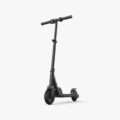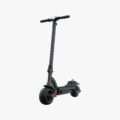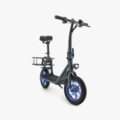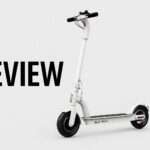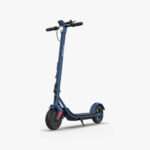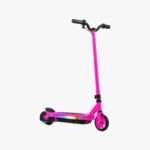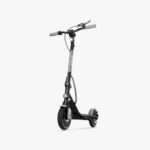- Home
- Scooters
- Electric Scooters
- Jetson Joust
Jetson Joust



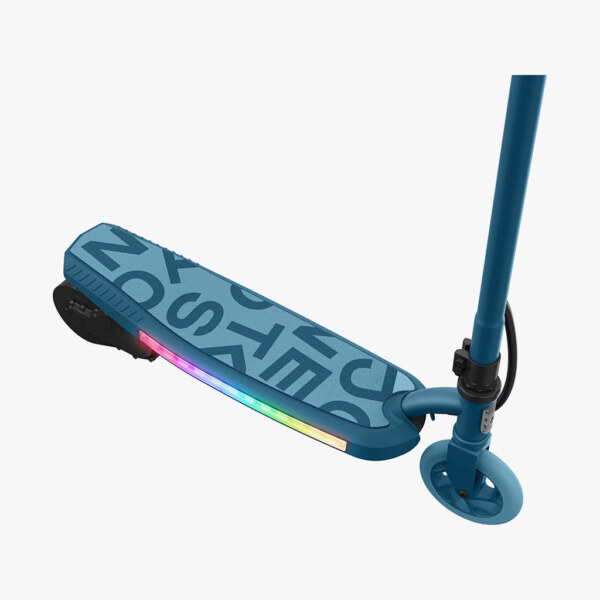
- Battery Range: Not specified
- Top Speed: 8.2 mph (13 km/h)
- Motor Power: 120 W
- Weight Capacity: 120 lb (54.4 kg)
- Charging Time: ~Up to 8 h
- Scooter Weight: 20.4 lb (9.3 kg)
PROS
- LED lights for visibility
- 120 W motor with thumb throttle
- Kickstand included
- Compact 29.5 × 20.5 × 36.6 in
- Runs up to 40 minutes
- Hand brake familiarity for kids
CONS
- No distance range stated
- Lead-acid battery
- IP rating not specified
Key Takeaways
- The Jetson Joust is a compact kids’ electric scooter designed for riders aged eight and up, featuring simple controls and bright lights.
- It offers a maximum speed of 8.2 mph, a 120 W rear hub motor, and a user-friendly thumb throttle for easy acceleration.
- The scooter provides up to 40 minutes of ride time per full charge and weighs 20.4 lbs, making it portable for parents to carry.
- It features a rear fender brake, LED lights for visibility, and a sturdy design that promotes safe riding for children.
- Overall, the Jetson Joust is perfect for short, smooth rides in neighborhoods, helping kids learn throttle control and enjoy outdoor fun.
Table of contents
- What Is the Jetson Joust?
- How the Jetson Joust Works
- Key Specifications
- Design & Build Quality
- How the Jetson Joust Handles
- Braking & Safety Features
- Portability & Daily Usability
- Maintenance & Care
- Weather & Seasonal Considerations
- Jetson Joust vs Alternatives
- Who the Jetson Joust Is (and Isn’t) For
- How to Get Kids Started the Right Way
- Troubleshooting Basics
- Maintenance Schedule You Can Follow
- Weather & Seasonal Safety Tips
- The Bottom Line
The Jetson Joust is a compact kids’ electric scooter for quick neighborhood rides and school-lot fun. It suits riders around eight and up who want simple controls and bright lights. Parents like the modest speed, the easy care, and the steady feel at low to medium pace. So it’s a friendly first step into powered scooting.
What Is the Jetson Joust?
The Jetson Joust is a kids’ e-scooter with a small rear hub motor, a thumb throttle, and a rear fender brake. It comes with light-up accents for visibility and a clean, grippy deck that helps young riders stand with a stable stance. Jetson built it for grade-schoolers, not teens or adults. So the speed cap, the weight limit, and the control layout all match that goal.
The frame is compact. The handlebar height fits most eight to twelve year olds, and the deck is short and secure. The wheels use a hard compound that shrugs off punctures, and upkeep stays simple. Plus the scooter is light enough for an adult to carry one-handed up stairs or to the trunk.
How the Jetson Joust Works
The Joust uses a 120 W hub motor inside the rear wheel, and that design keeps moving parts to a minimum. A child presses the thumb throttle to go, then the controller meters power so speed builds in a smooth arc. Most starts need a gentle kick first, and that habit teaches balance before power arrives. It also eases strain on the motor.
Power comes from a 24 V lead-acid battery pack. Lead-acid cells weigh more than lithium cells, but they deliver steady output for short rides. The controller is a simple board that reads throttle input and routes current to the motor. Heat stays low because the motor is small and speed is limited. Then, when it’s time to slow down, the rear fender brake provides the stopping force. Kids learn to press the fender with the heel for light stops, and to press harder for quicker stops.
Lights along the deck and stem improve visibility at dusk, and the built-in kickstand makes parking easy. Daily use is straightforward. Charge after a ride, unplug when the indicator shows full, and store in a dry spot. Do those things, and the scooter stays ready.
Key Specifications
| Block | Item | Value |
|---|---|---|
| General | Model Name | Jetson Joust Kids’ Electric Scooter |
| Recommended Rider Age | 8+ years | |
| Weight Limit | 120 lb (54.4 kg) | |
| Product Weight | 20.4 lb (9.25 kg) | |
| Performance & Power | Motor | 120 W rear hub motor |
| Top Speed | 8.2 mph (13.2 km/h) | |
| Maximum Gradient | 5° (~8.7% grade) under ideal conditions | |
| Wheel Size | 5.5 in (140 mm) | |
| Battery, Charging & Electrical | Battery Type | 24 V, 4.5 Ah lead-acid (≈108 Wh) |
| Maximum Run Time | Up to 40 minutes per full charge | |
| Charging Time | Up to 8 hours | |
| Charger | Dedicated wall charger, barrel port | |
| Build & Dimensions | Frame | Compact kids’ frame, fixed stem |
| Deck | Anti-slip grip surface | |
| Unfolded Dimensions (L × W × H) | 29.5 × 20.5 × 36.6 in (749 × 521 × 930 mm) | |
| Folded Dimensions | Not foldable. Fixed-stem design | |
| Safety & Control | Throttle | Thumb throttle with kick-to-start |
| Primary Brake | Rear fender foot brake | |
| Lights | Integrated LED accents | |
| Kickstand | Yes | |
| Features & Extras | Ride Modes | Single simple mode for kids |
| Cruise Control | Not included | |
| App/Firmware | Not applicable | |
| Warranty & Compliance | Warranty | Limited manufacturer warranty terms apply |
| Rider Guidance | Helmet and protective gear recommended. Follow local rules |
These specifications cover what parents and young riders need most. Units appear in both imperial and metric for quick reading.
Design & Build Quality
The frame feels sturdy for its size, and the one-piece fixed stem reduces flex. That matters for kids because a simple front end keeps steering consistent. The cockpit uses a thumb throttle on one side and standard rubber grips. The grips feel soft yet secure, so small hands stay relaxed on short rides.
The deck is short on purpose. Most young riders place the front foot across the deck and angle the rear foot. The anti-slip tape keeps shoes planted, and the deck edges are smooth so ankles stay safe. The rear fender sits close to the tire for a direct brake feel, and it has enough stiffness to handle repeated stops from low speed.
Fit and finish are tidy. Panel gaps are small, wires run neatly along the stem, and the charge port cap seats well when closed. The kickstand swings down with a firm detent, and the LED accents are bright enough to stand out at dusk. So the scooter looks clean and holds up to daily kid use.
How the Jetson Joust Handles
Performance Fundamentals
Acceleration is calm and predictable, and that’s exactly what you want for a first e-scooter. The 120 W motor gives a gentle push from a walking start, then it settles into a steady cruise. Top speed sits near 8.2 mph, which feels brisk on flat ground for a child.
Stability is best on smooth sidewalks and clean asphalt. The wheelbase is short, and the center of gravity stays low, so straight-line tracking feels planted at its capped speed. The handlebar width fits small shoulders and helps kids keep a slight elbow bend. In steady turns, the scooter holds a line and does not invite weaving. Riders learn to lean into a turn, then stand tall as they exit.
Hill climbs are limited by power. On gentle slopes around 7–9% grade, speed will drop, and a small running start helps. Long or steep hills aren’t its home, so plan routes with flatter streets and park paths. Do that, and rides stay fun without draining the battery fast.
Battery, Range & Efficiency
The pack is a 24 V, 4.5 Ah lead-acid unit, which totals about 108 Wh. Lead-acid chemistry delivers a steady voltage curve for most of a ride, then it drops near the end. In day-to-day use you can expect up to 40 minutes of ride time at a mix of low and medium speeds on flat ground.
Real-world range depends on a few things, and they’re easy to manage. Rider weight changes the load on the motor, terrain changes the duty cycle, and temperature affects chemistry. Warm weather near room temperature helps the pack hold voltage, while cold days below 50°F (10°C) shorten run time. Wind plays a part too, since a headwind makes the motor work harder. So plan short out-and-back routes with a buffer, and you’ll finish with charge to spare.
Charging is simple. Plug the barrel connector into the port on the deck, then plug the brick into the wall. A full charge from empty can take up to eight hours. Best practice is to charge after a ride, then unplug once full. Do not store the scooter empty for long. If it sits a month, give it a top-up. Those easy habits help the pack last.
Ride Quality & Comfort
The 5.5-inch wheels use a hard material with no inner tube, and that design limits flats while setting a firm ride. On smooth pavement the scooter glides with little noise. On cracked sidewalks, small wheels pass more bumps to the deck, so kids should keep a slight knee bend to absorb rough patches. The fixed stem keeps steering precise, and the grips add some cushion for small hands.
Ergonomics suit young riders well. The deck height is low and helps with control. The thumb throttle sits where a small hand can reach it without stretching. The brake fender responds to gentle pressure, and with practice a child learns to modulate braking by shifting a bit of weight back and pressing in one smooth motion.
Stem flex is minimal because the scooter does not fold, so straight-line stability stays consistent at the top speed. A narrow bar could feel twitchy, but the width here keeps steering natural. Braking from top speed to a stop takes a short distance when the rider eases off the throttle first and then applies firm heel pressure.
Braking & Safety Features
The rear fender is the primary brake. It clamps the rear wheel when pressed, and kids should learn a simple sequence. Roll off the throttle, stand tall, then press the fender. That approach shortens stopping distance and helps prevent skids. On loose gravel or wet leaves, coast earlier and use lighter pressure to keep grip.
The scooter includes LED accents that boost visibility, and they add a bit of fun. Add a front clip-on light and a bell if your routes get busy at dusk, and choose a bright helmet for extra visibility. A steady helmet habit is the best safety step for any scooter.
Water protection is basic. Avoid deep puddles and heavy rain, since wet riding reduces brake effectiveness and tire grip. If the scooter gets splashed, wipe it dry and let it air before charging.
Portability & Daily Usability
At about 20 lb, an adult can lift the Joust with one hand, and that helps with stairs or quick car trips to a park. The kickstand holds the scooter upright on level ground. For storage, keep it on a small mat in a hallway or garage corner. Because the stem does not fold, measure height against your space first. The footprint is small, though, so it fits most closet nooks.
For school pickups and short errands, the capped speed fits neighborhood limits. The scooter is quiet too, so morning rides won’t wake anyone. For security, bring it indoors when possible, and keep the charger and any tools out of reach of small kids. Make a simple rule. Ask an adult before charging.
Maintenance & Care
Build a quick weekly check that kids can help with. First, confirm the handlebar is tight by holding the front wheel between your feet and twisting each grip. It should not move. Next, press the brake fender a few times to be sure it springs back cleanly. Then, check wheel fasteners by hand. If anything feels loose, tighten with the proper tool.
Keep the deck clean. Wipe dust and grit with a damp cloth, and do not hose the scooter. Check the charge port cap for a snug fit, and inspect wire routing along the stem. If the scooter bumped a curb, look for cracks around the fender and deck. Replace grip tape once it feels slick.
For the battery, avoid deep discharge. Plug in after rides, and if it will sit for weeks, store it full in a cool, dry room. Once a month, top it off. Keep the charger off the floor where water could pool. Teach kids to unplug by gripping the plug, not the cable.
Create a seasonal routine. In spring, do a full bolt check and a deck deep clean. In summer, park in the shade and avoid hot car trunks. In fall, wipe the scooter dry after leaf-strewn rides. In winter, store indoors and charge at room temperature.
Weather & Seasonal Considerations
Rain lowers traction and weakens brake bite. Plan dry-day rides when you can. If the ground is damp, slow down, coast into turns, and leave more room before stops. Skip puddles that might hide potholes. Water can enter bearings and the charge port, so wipe the scooter dry after any splash and wait before charging.
Heat affects the battery. On hot days above 90°F (32°C), park the scooter in the shade, and never leave it in a sealed car. Heat reduces cell life and can swell a lead-acid pack. Cold shortens run time. On days below 50°F (10°C), expect shorter rides, start with a full charge, and keep speeds gentle. Gloves help small hands keep a relaxed grip.
Wind matters as well. A headwind makes the motor work harder, and a tailwind adds speed. Coach kids to ease off the throttle on downwind stretches. Dry leaves and sand can act like marbles, so slow before patches and ride straight until the surface is clean again.
Jetson Joust vs Alternatives
The Jetson Joust fits squarely in the kids’ class. It beats a regular kick scooter for cruising because the motor keeps speed without constant pushing. It does not try to match adult commuter scooters for range or hill power, and that’s fine. Its capped speed, simple brake, and compact size are there for younger riders.
Against small commuter scooters, the Joust is lighter and simpler. Adult models add folding stems, larger batteries, and stronger motors. They climb better and go faster, but they weigh more and can feel twitchy for a child. The Joust keeps things gentle, and that is the point.
Against performance scooters, the comparison is apples to oranges. Big dual-motor machines are fast and heavy, and they are not for kids. The Joust targets safe, short rides on sidewalks and park paths. If a family later wants more power for a teen, that is the time to step up to larger wheels and a lithium pack.
If you are browsing kids’ options, you might also scan similar compact models for context. For instance, here is a kid-size pick with light weight and simple controls, the DXH Kids E-Scooter, and here is a comparable Jetson option tuned for young riders, the Jetson Racer. Those examples help frame what the Joust aims to do.
Who the Jetson Joust Is (and Isn’t) For
The Jetson Joust fits kids around eight and up who want smooth, short rides close to home. It shines in cul-de-sacs, school lots, and quiet streets where steady handling matters. Students who want a first taste of throttle control learn fast on this scooter. Multi-modal trips are easy too, since an adult can lift it into a trunk without strain.
It is not for adults, long commutes, or steep neighborhoods. It is not for off-road trails with roots and rocks. Families who live among big hills should look for a stronger motor and larger wheels when a child grows. For flat suburbs with smooth sidewalks, this scooter offers a sensible way to build skills and enjoy fresh air.
How to Get Kids Started the Right Way
Sizing the fit. Have your child stand on the deck with both feet. Elbows should have a slight bend while holding the grips. If the bar feels too low, the scooter may be small. If the bar hits the chest, swap to firmer shoes that add a bit of height, or consider a taller model.
First ride routine. Pick a quiet, flat area. Show how to push once, stand steady, then press the thumb throttle slowly. Practice coasting and braking at walking speed, and only then try a full-throttle pass. Keep one rule clear. Eyes ahead, both hands on, both feet inside the deck edges.
Neighborhood etiquette. Yield to pedestrians and slow near driveways. Call out “on your left” when passing on a path. Make eye contact with drivers at crossings. Talk about weather and surface clues, then point them out in real time so kids connect words with feel.
Charging routine. Plug in after rides, check the indicator, and unplug when it reads full. Coil the charger neatly and store it high on a shelf. That habit protects cables from pets and small siblings.
Storage routine. Park with the kickstand on a firm surface. Keep the scooter out of rain and away from sprinklers. Wipe the charge port dry before closing the cap.
Troubleshooting Basics
Scooter will not start. Confirm the power state and the charge level. Check the charge port cap and seat the plug fully. Make sure the throttle is not pressed during power-on, since many controllers lock out if they see an open throttle at start.
Short run time after storage. Top off the battery and ride a short loop, then recharge. If run time stays short, cold weather or an aging pack is likely. Keep routes brief and flat until you can service the battery.
Weak braking feel. Check the fender hinge and confirm no debris jams the rear wheel. Clean the wheel surface, then coach your child to shift a touch of weight rearward and press the fender with a smooth motion.
Noisy wheel. Inspect for trapped gravel. Spin the wheel by hand and listen, then remove small stones near the fender with a soft brush.
Maintenance Schedule You Can Follow
Before each ride. Quick visual check, brake fender press test, and a throttle on-off test. Then confirm the kickstand springs back.
Weekly. Grip-twist test for bar tightness, wheel fastener feel check, and a wipe-down of the deck and stem. Next, inspect the charge port cap.
Monthly. Full bolt check with the proper tools, wire-routing inspection, and a look for cracks near the fender. Replace worn grip tape. Then check the charger cable and brick for damage.
Seasonal. Spring deep clean and bolt check. Summer shade storage and no hot-trunk time. Fall wipe-downs after leaf rides. Winter indoor storage and room-temperature charging.
Weather & Seasonal Safety Tips
Wet surfaces. Slow down, coast into turns, and extend stopping distance. Skip puddles, then dry the scooter after. Wait before charging.
Heat and cold. On hot days, park in shade. On cold days, expect shorter rides. Start charged, keep speeds steady, and use gloves for grip.
Wind and debris. Ease the throttle when riding with a tailwind, and hold a steady line through dry leaves or sand. Then resume normal speed once the surface is clear.
The Bottom Line
The Jetson Joust keeps kids smiling with simple controls, bright lights, and a safe top speed. Parents get peace of mind from gentle acceleration, a straightforward brake, and a light frame you can carry without fuss. It is not built for hills or long range, and it does not fold. That’s fine. It does exactly what a first kids’ e-scooter should do. Short trips, steady cruising, and easy care.
Plan routes with smooth surfaces, build a basic maintenance routine, and keep charging habits simple. If your child wants more power later, you will know what to look for next. For now, this scooter offers a friendly start to electric scooting and a fun way to spend time outside.
Specifications
General
| Model The Model specifies the exact version or name of the scooter. It helps identify its unique design, features, and specifications within the manufacturer’s product line. Knowing the model makes it easier to compare options, find compatible accessories, or look up support information. | Joust |
| Brand The Brand identifies the manufacturer or company that designs and produces the scooter. A trusted brand is a sign of quality, reliability, and good customer support. Well-known brands often have higher standards for safety, performance, and after-sales service, giving you more confidence in your purchase. | Jetson |
| Release Date The Release Date indicates when the scooter model was officially launched on the market. This helps you know how current the design, technology, and features are. A newer release date often means updated components, improved performance, and the latest safety or smart features. | 18 November 2025 |
| Recommended Age Recommended Age indicates the minimum age range that the scooter is designed for, based on safety, size, and ease of use. Following the recommended age helps ensure that riders can handle the scooter’s speed, weight, and controls comfortably and safely. Always check local laws and use protective gear, especially for younger riders. | 8+ |
Performance & Power
| Motor Power (Wattage) What it means: The motor power, measured in watts (W), shows how strong the scooter’s electric motor is. Why it matters: Higher wattage usually means better acceleration, more torque, and improved performance on hills or rough terrain. For example, a 250W motor is good for flat city roads and light riders, while a 500W or 1000W motor provides more power for faster speeds or climbing steep inclines. | 120 W hub motor |
| Top Speed The Top Speed indicates the maximum speed that the scooter can reach under optimal conditions. It’s usually measured on level ground with a fully charged battery and an average rider weight. A higher top speed allows you to travel longer distances faster, but always ensure you ride within legal speed limits and your personal comfort zone for safety. | 8.2 mph (13 km/h) |
| Battery Capacity Battery Capacity refers to the total amount of energy the scooter’s battery can store, usually measured in ampere-hours (Ah) or watt-hours (Wh). A higher battery capacity means you can ride longer distances on a single charge, reducing the need for frequent recharging. Keep in mind that actual range can vary depending on rider weight, terrain, speed, and weather conditions. | 24 V 4.5 Ah lead-acid (~108 Wh) |
| Estimated Range per Charge The Estimated Range per Charge indicates the average distance the scooter can travel on a single full battery charge. This range is calculated under optimal conditions, such as flat terrain, moderate speed, and average rider weight. Real-world range may vary depending on riding style, terrain, weather, and load. A longer range means fewer recharges and greater freedom for longer trips. | Not specified |
| Hill Climb Ability Hill Climb Ability describes the maximum incline or slope that the scooter can handle while maintaining stable performance. It’s typically expressed as a percentage or in degrees. A higher hill climb rating means the scooter can tackle steeper hills without losing too much speed or power. Actual climbing performance may vary based on rider weight, battery charge, and terrain conditions. | Up to 5° |
| Drive System The Drive System refers to how power from the motor is delivered to the wheels. Electric scooters typically use either a hub motor (directly integrated into the wheel) or a chain/belt drive system. A high-quality drive system ensures smooth acceleration, efficient power transfer, and low maintenance. The choice of drive system affects performance, noise level, and overall ride experience. | Not specified |
Charging & Electrical
| Charging Time Charging Time indicates how long it takes to fully recharge the scooter’s battery from empty to 100% using the standard charger provided. Faster charging means less downtime and more time on the road. Actual charging time may vary slightly depending on battery capacity, charger output, and environmental conditions. | Up to 8 hours |
| Battery Type Battery Type refers to the specific technology used in the scooter’s battery, which affects performance, lifespan, weight, and charging time. Most modern electric scooters use high-quality lithium-ion (Li-ion) batteries because they offer a good balance of energy density, durability, and low maintenance. A reliable battery type ensures consistent power delivery and longer riding ranges. | Lead-acid with basic protection |
| Removable Battery A Removable Battery means the battery pack can be easily detached from the scooter for convenient charging and replacement. This feature allows you to charge the battery separately, swap it with a spare for extended range, or securely store it indoors in extreme weather. Removable batteries add flexibility and make it easier to keep your scooter powered up wherever you are. | Non-removable internal battery |
| Regenerative Braking Regenerative Braking is an energy-saving feature that converts some of the energy normally lost during braking back into battery power. When you slow down or brake, the motor works in reverse to generate electricity, which helps extend the scooter’s range and improves overall efficiency. This system also reduces wear on traditional brake components, leading to lower maintenance over time. | No |
| Lighting Lighting refers to the built-in front and rear lights that enhance visibility and safety when riding in low-light conditions or at night. Good lighting helps you see the road ahead and ensures that other road users can see you. Many scooters include LED headlights, taillights, and sometimes brake lights or side reflectors for added safety and compliance with local traffic regulations. | LED deck lighting. reflectors |
Build & Dimensions
| Scooter Weight Scooter Weight refers to the total weight of the scooter when fully assembled, including the battery. This affects how easy it is to carry, lift, and store the scooter when not in use. A lighter scooter is more portable and convenient for commuting, especially if you need to carry it upstairs or onto public transport. Keep in mind that a sturdy frame and quality components may add to the weight but also contribute to better durability and ride stability. | 20.4 lb (9.3 kg) |
| Maximum Rider Weight Maximum Rider Weight indicates the highest rider weight that the scooter is designed to safely support while maintaining optimal performance and stability. Staying within this limit helps ensure reliable acceleration, braking, and climbing ability, and it protects the frame, suspension, and motor from excessive strain. Exceeding the recommended limit may reduce performance and increase wear on components. | 120 lb (54.4 kg) |
| Deck Size Deck Size refers to the dimensions of the scooter’s standing platform. A wider and longer deck provides more foot space, allowing you to stand comfortably and adjust your stance while riding. A well-sized deck improves balance and stability, especially on longer rides or at higher speeds. Compact decks, on the other hand, help keep the scooter lightweight and portable. | Kids deck with grip tape |
| Handlebar Height Handlebar Height refers to the distance from the deck to the handlebars, which affects your riding posture and comfort. An appropriate handlebar height helps you maintain good balance, reduces strain on your back and arms, and makes steering more comfortable. Some scooters have adjustable handlebars to fit riders of different heights, while others have a fixed height for a streamlined design. | Fixed |
| Folding Mechanism The Folding Mechanism describes how easily and securely the scooter can be folded for carrying and storage. A well-designed folding system lets you quickly collapse the scooter into a compact size, making it convenient to transport on public transit, store under a desk, or fit into a car trunk. Look for sturdy latches and safety locks to ensure the scooter stays firmly in place when folded or unfolded. | Quick-fold latch |
| Dimensions Folded Dimensions indicate the size of the scooter when it’s fully folded. This measurement shows how much space the scooter will take up when stored or carried, making it easier to check if it will fit in your car trunk, under a desk, or in a closet. Compact folded dimensions are ideal for commuters who need to bring their scooter on public transport or store it in tight spaces. | Unfolded: 29.5 × 20.5 × 36.6 in. Folded: Not specified |
| Material Material refers to the primary construction materials used for the scooter’s frame and key components. High-quality materials like aircraft-grade aluminum, reinforced steel, or durable composites provide strength, stability, and a lighter overall weight. A sturdy material ensures the scooter can handle daily wear and tear while maintaining safety and performance. | Not specified |
Safety & Control
| Brake Type(s) Brake Type(s) describe the braking systems the scooter uses to help you slow down or stop safely. Common brake types include mechanical brakes (like drum or disc brakes), electronic brakes, and foot brakes. Many scooters combine multiple braking systems for added safety and shorter stopping distances. The type and quality of brakes affect your control, especially when riding at higher speeds or on slopes. | Hand brake + rear foot brake |
| Suspension Suspension refers to the system that absorbs shocks and vibrations while riding, providing a smoother and more comfortable ride over uneven or rough surfaces. Scooters may have front suspension, rear suspension, or dual suspension for better shock absorption and stability. Good suspension helps reduce rider fatigue and improves control, especially when riding on bumpy roads or off-road paths. | None |
| Tire Type Tire Type refers to the kind of tires the scooter uses, which directly affects ride comfort, traction, and maintenance. Common types include solid (airless) tires, pneumatic (air-filled) tires, or hybrid options. Pneumatic tires offer better shock absorption and a smoother ride on rough surfaces, while solid tires are puncture-proof and require less upkeep. The right tire type helps ensure safe handling and a comfortable ride in different conditions. | 5.5″ solid tires |
| Tire Size Tire Size indicates the diameter and width of the scooter’s tires, which affect ride comfort, stability, and how well the scooter handles different terrains. Larger tires generally offer better shock absorption and a smoother ride over bumps and rough surfaces, while smaller tires keep the scooter lighter and more portable. Choosing the right tire size helps ensure a balance between agility and comfort. | 5.5-inch |
| Kickstand The Kickstand is a built-in stand that allows you to park your scooter upright when it’s not in use. A sturdy kickstand keeps the scooter stable and prevents it from tipping over, protecting it from scratches and damage. It also makes storing and accessing your scooter more convenient, whether you’re at home, work, or on the go. | Side kickstand |
| Water Resistance Rating Water Resistance Rating indicates how well the scooter is protected against water and moisture, usually shown as an IP (Ingress Protection) rating. This rating helps you understand whether the scooter can handle light rain, splashes, or wet roads without damage. While most scooters are not fully waterproof, a good water resistance rating adds peace of mind when riding in changing weather conditions. Always avoid deep puddles or submerging the scooter to protect its electrical components. | Not specified |
Features & Extras
| Display/Console The Display (or Console) shows important real-time information about your ride, helping you monitor your scooter’s status at a glance. Typical displays show speed, battery level, distance traveled, and riding mode. Some models also include additional features like Bluetooth connectivity, app integration, or backlighting for better visibility at night. A clear and easy-to-read display enhances safety and convenience on every trip. | No display stated |
| Ride Modes Ride Modes refer to the different speed and power settings you can choose to match your riding style or road conditions. Common modes include eco for maximum range and energy efficiency, standard for everyday balance, and sport or turbo for higher speed and stronger acceleration. Switching between ride modes allows you to customize performance, conserve battery, and ride safely in various environments. | Not specified |
| Smart App Connectivity Smart App Connectivity lets you pair your scooter with a dedicated mobile app via Bluetooth. Using the app, you can monitor real-time ride stats like speed, battery level, and range, adjust settings such as ride modes or cruise control, lock the scooter for added security, and sometimes receive firmware updates. This feature adds convenience and allows you to personalize your riding experience right from your smartphone. | No app |
| Anti-Theft System The Anti-Theft System helps protect your scooter from unauthorized use or theft. This feature can include built-in alarms, electronic motor locks, GPS tracking, or remote locking through a mobile app. A good anti-theft system provides peace of mind when parking your scooter in public spaces, adding an extra layer of security to safeguard your investment. | Power switch only |
| Cruise Control Cruise Control allows you to maintain a steady speed without continuously holding the throttle. This feature makes longer rides more comfortable by reducing hand fatigue and providing a smoother, more relaxed riding experience — especially on flat, open roads or bike lanes. For safety, cruise control can usually be easily activated or deactivated while riding. | No |
| Accessories Included Accessories Included lists the additional items that come with the scooter to enhance your riding experience and convenience. Common accessories may include a charger, kickstand, bell, lights, phone holder, or carrying strap. These extras add value by making your scooter safer, easier to use, and ready to ride straight out of the box. | Scooter. charger. manual |
Warranty & Compliance
| Warranty Period The Warranty Period indicates how long the manufacturer guarantees the scooter against defects in materials and workmanship under normal use. A good warranty provides peace of mind, showing the brand’s confidence in its product quality. Always check what parts are covered, such as the frame, battery, and motor, and follow the maintenance guidelines to keep your warranty valid. | 180 days |
| Certifications Certifications confirm that the scooter meets specific safety, quality, and environmental standards set by recognized organizations or regulatory bodies. Common certifications may include CE, RoHS, UL, or other local compliance marks, depending on your region. These certifications ensure that the scooter is manufactured to high standards and is safe and legal to use in your country. | Region-dependent |


